They work hard for the honey
These days, Dina can’t walk a block without stopping ten times. It’s not because she’s 37 weeks pregnant. Rather, it’s her irrepressible urge to bury her face in the riot of color and smells pushed out of the ground by spring. “So many colors!!!” she’ll exclaim, dragging me from a perky tulip to a puff of cherry blossoms, the splotch of yellow pollen covering the tip of her nose growing ever larger.This is nature at it’s most seductive. And though Dina falls hook line and sinker, this furious display is really meant to attract much smaller pollinators – insects lured by nectar and scent to play amongst the pistils and stamens, spreading pollen in the process. And of the pollinators, perhaps the best-known are honeybees.Though they may be the best-known, they’re also imperiled – a fact evident on our walk this weekend. The hyacinths and forsythia we passed were nearly silent, save a few lone workers solemnly going about their business. This is not normal – plants in bloom right now should be literally vibrating with activity.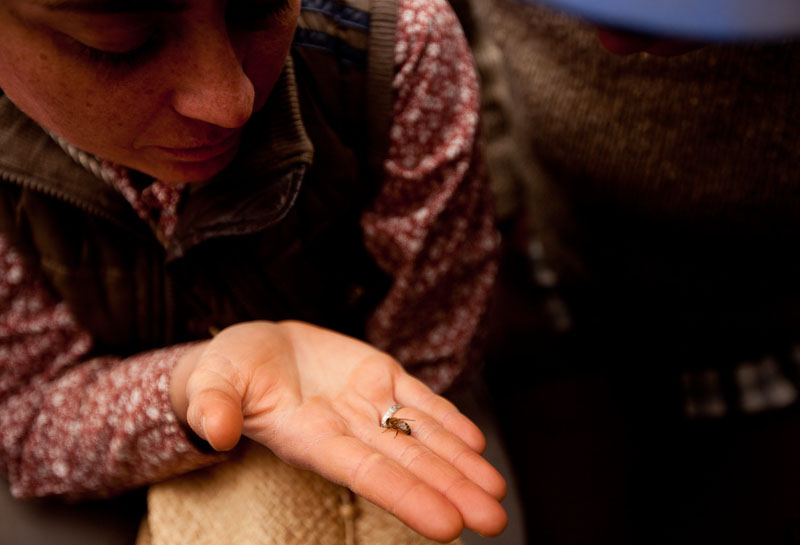 Here at the farm, our bees have fared poorly, too. We just opened our four hives to see how the colonies overwintered and we encountered a scene straight out of Pompeii: thousands of bees in suspended animation, frozen in the tasks they were doing when they all mysteriously died: filling cells with nectar, warming the hive and their queen by beating their wings. Exactly why the colony died is probably a result of a combination of factors, but it’s part of a stupefying worldwide phenomenon called colony collapse disorder.
Here at the farm, our bees have fared poorly, too. We just opened our four hives to see how the colonies overwintered and we encountered a scene straight out of Pompeii: thousands of bees in suspended animation, frozen in the tasks they were doing when they all mysteriously died: filling cells with nectar, warming the hive and their queen by beating their wings. Exactly why the colony died is probably a result of a combination of factors, but it’s part of a stupefying worldwide phenomenon called colony collapse disorder.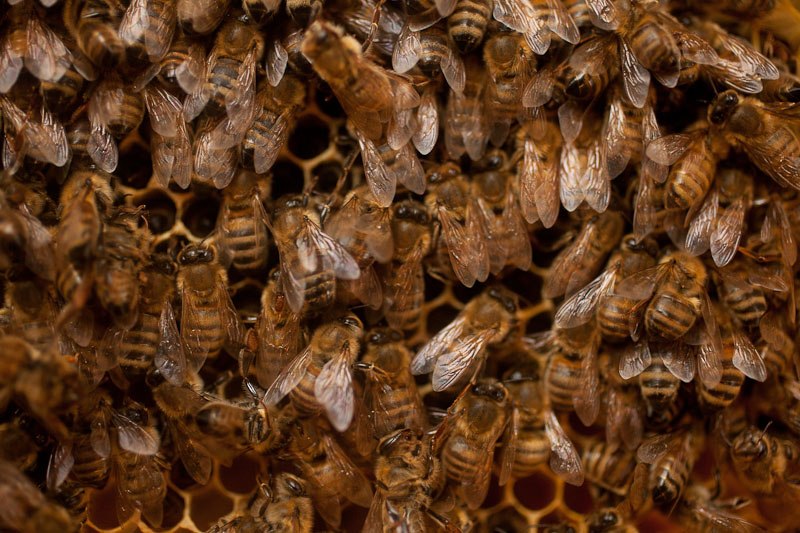 So with nothing left for us to do this year but start over, we installed two new packets of bees and wished them better luck than their predecessors. We count on them to bring forth fruit from our crops, so we have a lot riding on their success too.Bees. Are. Amazing. And (que Donna Summers) they work hard for the honey. To yield a mere one pound of honey, 10,000 bees must visit 2,000,000 flowers, flying the equivalent of two times around the world in the process. (A single honeybee only makes a tenth of a teaspoon of honey over the course of her life.) And honey is the ultimate doomsday prep food – the stuff can keep indefinitely. Excavators have found thousand-year-old honey in the burial crypts of Pharaohs that is still pure and flowing.To this, Tyson our professor of all-things-bee exclaimed, “WHAAAAT?!” slamming his fist down on the table for emphasis, warning us that it only gets crazier.
So with nothing left for us to do this year but start over, we installed two new packets of bees and wished them better luck than their predecessors. We count on them to bring forth fruit from our crops, so we have a lot riding on their success too.Bees. Are. Amazing. And (que Donna Summers) they work hard for the honey. To yield a mere one pound of honey, 10,000 bees must visit 2,000,000 flowers, flying the equivalent of two times around the world in the process. (A single honeybee only makes a tenth of a teaspoon of honey over the course of her life.) And honey is the ultimate doomsday prep food – the stuff can keep indefinitely. Excavators have found thousand-year-old honey in the burial crypts of Pharaohs that is still pure and flowing.To this, Tyson our professor of all-things-bee exclaimed, “WHAAAAT?!” slamming his fist down on the table for emphasis, warning us that it only gets crazier.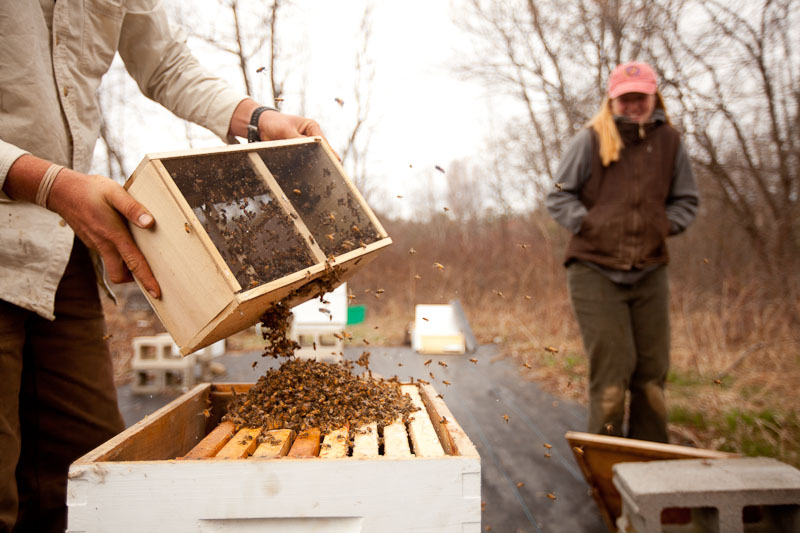 A typically hive has as many as 60,000 bees at the height of the summer. The hierarchy breaks down like this: at the bottom rung, you have the worker bees. They do all the, well… work. They clean the hive, protect it from intruders, gather nectar and pollen, feed the growing larva, and take care of the queen. They’re born ready to get straight to work, and over the course of their month-long life, graduate from one task to the next as they age. And guess what? They’re all female.The males have it a bit better – until they suddenly die, that is. They’re called drones – big, fat, lazy bees (they can’t even hatch without help) that pass their days waiting to have sex with the queen. They have no other job.At the top of the hierarchy is the queen bee – literally. Her job from birth to death is to lay eggs – as many as 2,000 per day – and to carry on the genetic line of the hive.When all is well, the queen gives off a royal scent signaling, “I’m in charge, I’m laying eggs. Continue about your business.” But if that scent isn’t being circulated or if the queen loses the confidence of her attendant worker bees, they will secretly construct a special cell to hatch a new queen – a process that begins with the old queen unknowingly laying the egg that will become her replacement. All the eggs themselves are identical and hatch into larva, but if one is singled out to become a replacement queen, it is fed “Royal Jelly” (a mixture pollen and nectar), which cements her status and completes the transformation. And as soon as she emerges from her cell, she’ll immediately seek out the old queen and engage her in a fight to the death.First the killing, then the sex: the new queen will then leave the hive and go on a “nuptial flight” to a predetermined mating site in the sky. (Every new generation of queens somehow knows the way to these sites even if the hive is not from the area.) During her flight, the she’ll mate with as many drones as she can find and collects all the sperm she’ll need for the rest of her 2-5 year life. As for the drones, well, their guts are literally ripped from their body as they fulfill their genetic destiny and they simply fall to their deaths. The queen returns to the hive and releases the sperm one by one from a special organ called the spermatheca to fertilize eggs as needed.“Homo Sapiens are so boooooring!” Tyson chimes in, slapping the table again.
A typically hive has as many as 60,000 bees at the height of the summer. The hierarchy breaks down like this: at the bottom rung, you have the worker bees. They do all the, well… work. They clean the hive, protect it from intruders, gather nectar and pollen, feed the growing larva, and take care of the queen. They’re born ready to get straight to work, and over the course of their month-long life, graduate from one task to the next as they age. And guess what? They’re all female.The males have it a bit better – until they suddenly die, that is. They’re called drones – big, fat, lazy bees (they can’t even hatch without help) that pass their days waiting to have sex with the queen. They have no other job.At the top of the hierarchy is the queen bee – literally. Her job from birth to death is to lay eggs – as many as 2,000 per day – and to carry on the genetic line of the hive.When all is well, the queen gives off a royal scent signaling, “I’m in charge, I’m laying eggs. Continue about your business.” But if that scent isn’t being circulated or if the queen loses the confidence of her attendant worker bees, they will secretly construct a special cell to hatch a new queen – a process that begins with the old queen unknowingly laying the egg that will become her replacement. All the eggs themselves are identical and hatch into larva, but if one is singled out to become a replacement queen, it is fed “Royal Jelly” (a mixture pollen and nectar), which cements her status and completes the transformation. And as soon as she emerges from her cell, she’ll immediately seek out the old queen and engage her in a fight to the death.First the killing, then the sex: the new queen will then leave the hive and go on a “nuptial flight” to a predetermined mating site in the sky. (Every new generation of queens somehow knows the way to these sites even if the hive is not from the area.) During her flight, the she’ll mate with as many drones as she can find and collects all the sperm she’ll need for the rest of her 2-5 year life. As for the drones, well, their guts are literally ripped from their body as they fulfill their genetic destiny and they simply fall to their deaths. The queen returns to the hive and releases the sperm one by one from a special organ called the spermatheca to fertilize eggs as needed.“Homo Sapiens are so boooooring!” Tyson chimes in, slapping the table again.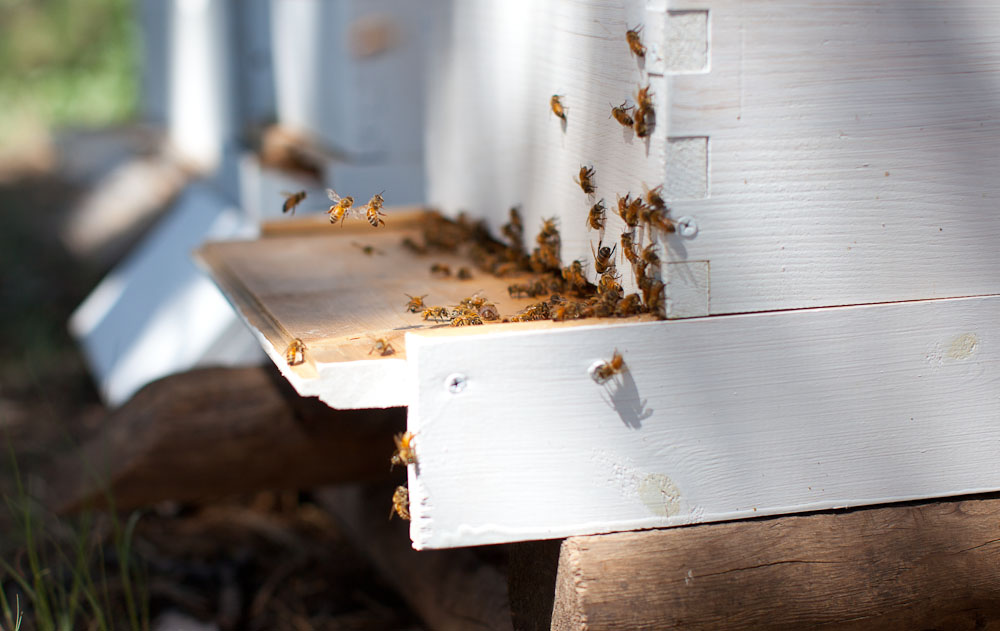 Once the queen is back in the hive and laying eggs again, work resumes. Worker bees communicate the location of blossoms to each other with elaborate dances that reference, among other things, the angle of the sun, specific visual clues and the earth’s magnetic fields. And in the process of gathering their food, they pollinate three-quarters of all crops worldwide.The extraordinary ways that the individual members of a hive communicate and function have led some to suggest that colonies are actually “super organisms” comprised of individual bees the same way our bodies are made of individual cells.Today, all this madness and beauty is in a precarious spot. Vast tracts of monocrops (visualize an industrial almond grove spanning thousand-square miles) limit the flowering (and thus food-gathering) window to a tiny fraction of time compared with the months-long pollen season of a diverse ecosystem. Resident pollinators can’t survive this feast-or-famine and, as a result, hundreds of bee colonies must be trucked from from California almond groves to Maine’s blueberries fields and everywhere in between in order to pollinate the crops. They’re the insect equivalent of migrant workers, but without them, there would be no fruit to pick. And along the way, the bee colonies accumulate synthetic pesticides that are used on conventional crops, which is one possible culprit in colony collapse disorder.To be fair, honeybees themselves are an “invasive species” in that they originally hail from Europe. So perhaps an equal amount of attention should be given to supporting native pollinators, which are already more resilient and adapted to this country (though not to monocrops).But without either the honeybees or native pollinators to make plant sex possible, we’re all in a bind. Unless we want to run around with Q-tips transporting pollen from flower to flower, we need bees to keep on doing their bee-thing. No pollination = no fruit, no seed and no more plants.
Once the queen is back in the hive and laying eggs again, work resumes. Worker bees communicate the location of blossoms to each other with elaborate dances that reference, among other things, the angle of the sun, specific visual clues and the earth’s magnetic fields. And in the process of gathering their food, they pollinate three-quarters of all crops worldwide.The extraordinary ways that the individual members of a hive communicate and function have led some to suggest that colonies are actually “super organisms” comprised of individual bees the same way our bodies are made of individual cells.Today, all this madness and beauty is in a precarious spot. Vast tracts of monocrops (visualize an industrial almond grove spanning thousand-square miles) limit the flowering (and thus food-gathering) window to a tiny fraction of time compared with the months-long pollen season of a diverse ecosystem. Resident pollinators can’t survive this feast-or-famine and, as a result, hundreds of bee colonies must be trucked from from California almond groves to Maine’s blueberries fields and everywhere in between in order to pollinate the crops. They’re the insect equivalent of migrant workers, but without them, there would be no fruit to pick. And along the way, the bee colonies accumulate synthetic pesticides that are used on conventional crops, which is one possible culprit in colony collapse disorder.To be fair, honeybees themselves are an “invasive species” in that they originally hail from Europe. So perhaps an equal amount of attention should be given to supporting native pollinators, which are already more resilient and adapted to this country (though not to monocrops).But without either the honeybees or native pollinators to make plant sex possible, we’re all in a bind. Unless we want to run around with Q-tips transporting pollen from flower to flower, we need bees to keep on doing their bee-thing. No pollination = no fruit, no seed and no more plants.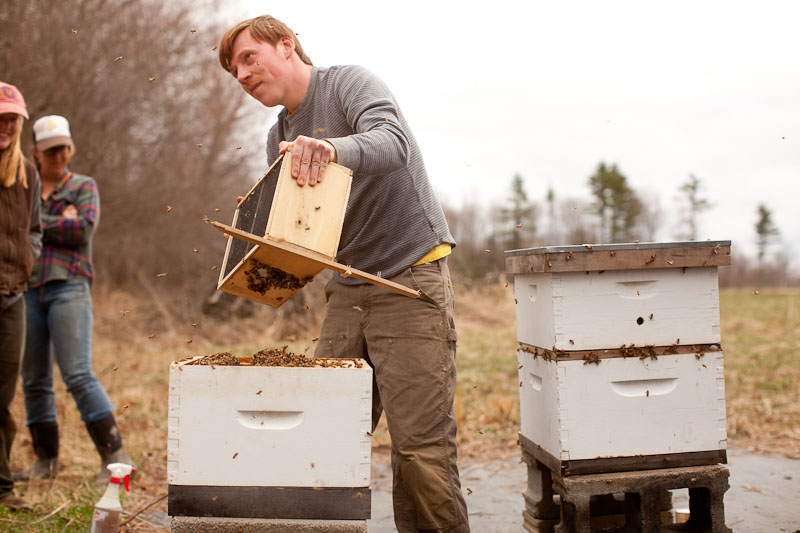 So far, the two replacement colonies we’ve installed have taken to their new homes quite nicely. Meanwhile, we’re watching and waiting for signs that the queen is laying eggs. And in honor of the astonishing bees and their sexually liberated leader, I’ll share with you the final stanza from a poem by author and beekeeper EB White:I’m sorry for creatures who cannot pairOn a gorgeous day in the upper air,I’m sorry for cows that have to boastOf affairs they’ve had by parcel post,I’m sorry for a man with his plots and guile,His test-tube manner, his test-tube smile;I’ll multiply and I’ll increaseAs I always have—by mere caprice;For I am a queen and I am a bee,I’m devil-may-care and I’m fancy-free,Love-in-air is the thing for me,Oh, it’s simply rare,In the beautiful air,And I wish to stateThat I’ll always mateWith whatever drone I encounter.
So far, the two replacement colonies we’ve installed have taken to their new homes quite nicely. Meanwhile, we’re watching and waiting for signs that the queen is laying eggs. And in honor of the astonishing bees and their sexually liberated leader, I’ll share with you the final stanza from a poem by author and beekeeper EB White:I’m sorry for creatures who cannot pairOn a gorgeous day in the upper air,I’m sorry for cows that have to boastOf affairs they’ve had by parcel post,I’m sorry for a man with his plots and guile,His test-tube manner, his test-tube smile;I’ll multiply and I’ll increaseAs I always have—by mere caprice;For I am a queen and I am a bee,I’m devil-may-care and I’m fancy-free,Love-in-air is the thing for me,Oh, it’s simply rare,In the beautiful air,And I wish to stateThat I’ll always mateWith whatever drone I encounter.
